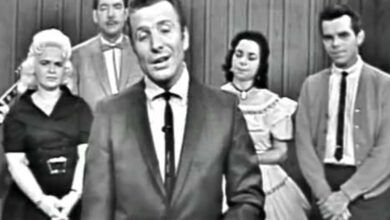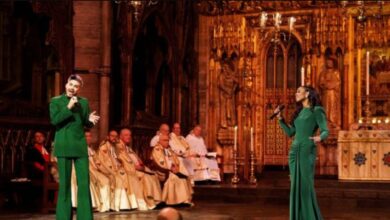Percy Faith’s “Theme from A Summer Place” – The Instrumental That Defined an Era
When “Theme from A Summer Place” was released in 1960, it became one of the most recognizable and enduring instrumental pieces in popular music history. Originally composed by Max Steiner for the 1959 film A Summer Place, the song took on a life of its own when Percy Faith and his orchestra recorded their version. With its sweeping strings and lush orchestration, the track became an emblem of romance and nostalgia, climbing to No. 1 on the Billboard Hot 100 and remaining there for an astonishing nine weeks. This feat made it the longest-running instrumental No. 1 in the history of the chart, solidifying its place as one of the defining soundscapes of the early 1960s.
Percy Faith, a Canadian-born bandleader, composer, and arranger, had already established himself as a master of orchestral pop music by the time he recorded “Theme from A Summer Place.” Born in 1908, Faith initially pursued a career as a pianist but transitioned to arranging and conducting after a hand injury curtailed his ability to perform. His style was characterized by lush string arrangements, warm harmonies, and a keen sense of melody—traits that made his music a favorite among audiences who appreciated sophisticated and cinematic compositions. Faith had already achieved success with several instrumental recordings, but “Theme from A Summer Place” would become his magnum opus.
The original version of the song, composed by Max Steiner, was used as the central theme for A Summer Place, a romantic drama starring Troy Donahue and Sandra Dee. While Steiner’s version was deeply embedded in the film’s score, Percy Faith’s arrangement transformed it into a standalone hit. Faith infused the piece with an even richer, dreamier quality, replacing the dramatic orchestration of the film score with a softer, flowing arrangement that emphasized melody and atmosphere. This shift made the song not just a movie theme but a universal expression of longing, nostalgia, and love.
The recording of “Theme from A Summer Place” was a testament to Faith’s skill as an arranger and conductor. His orchestra, composed of strings, woodwinds, and subtle percussion, created a sweeping soundscape that transported listeners to a serene, idealized world. Unlike many instrumental hits of the time, which often relied on brass-heavy arrangements or novelty elements, Faith’s version was purely about evoking an emotional response through melody. The gentle, cascading violins and warm orchestral backing gave the song an almost hypnotic quality, making it instantly recognizable even decades later.
Upon its release, the song was met with overwhelming acclaim. It not only topped the Billboard Hot 100 but also won the Grammy Award for Record of the Year in 1961—an achievement that remains rare for an instrumental recording. The song’s nine-week reign at No. 1 was a testament to its broad appeal, attracting listeners across multiple generations and musical tastes. At a time when rock and roll was beginning to dominate the charts, “Theme from A Summer Place” proved that lush, orchestral music still had a place in popular culture.
Beyond its commercial success, the song had a significant cultural impact. It became a symbol of romance and nostalgia, frequently used in films, television shows, and commercials to evoke a sense of timeless beauty. The track resonated particularly with the post-war generation, for whom it represented an era of innocence and idealized love. Its melody was often associated with tranquil summer evenings, beachside memories, and the golden age of Hollywood romance.
For Percy Faith, “Theme from A Summer Place” became his defining work, elevating him to a level of recognition that few instrumental artists achieved. Although he continued to release successful orchestral pieces, this song remained his most requested and most celebrated recording. It also cemented his influence on the easy listening genre, paving the way for later artists like Henry Mancini and André Kostelanetz, who similarly combined orchestral grandeur with popular accessibility.
The song’s influence extended well beyond Faith’s own career. It helped popularize the “orchestral pop” movement, bridging the gap between classical music and mainstream pop. Many artists, including Andy Williams, The Lettermen, and Billy Vaughn, recorded their own versions of the song, further demonstrating its wide appeal. While some covers added vocals or changed the arrangement slightly, none could match the original’s ethereal, dreamlike quality.
Even as musical tastes shifted in the following decades, “Theme from A Summer Place” retained its status as a cultural touchstone. It has been featured in countless films, TV shows, and advertisements, often used to evoke a sense of nostalgia or idyllic romance. Whether playing in the background of a classic Hollywood film montage or being used in a contemporary setting for ironic contrast, the song’s ability to evoke emotion remains unparalleled.
At the time of its release, the world was on the cusp of a new era in music. Rock and roll, Motown, and the British Invasion were about to redefine the industry, yet “Theme from A Summer Place” proved that there was still a place for orchestral compositions in the mainstream. Its success suggested that audiences still craved beauty and melody, even as the landscape of popular music was rapidly evolving.
More than six decades after its release, the song remains one of the most enduring instrumentals of all time. It continues to receive airplay on oldies stations, is frequently featured in retrospectives of classic hits, and still finds new audiences who appreciate its timeless charm. Even listeners who have never seen A Summer Place instantly recognize the melody, a testament to its universal appeal.
The legacy of “Theme from A Summer Place” extends beyond its status as a hit record. It influenced generations of composers and arrangers, proving that instrumental music could achieve mainstream success. Its lush orchestration set a high standard for film scores and easy listening records, and its melody remains one of the most instantly recognizable in popular music history.
In the grand scope of 20th-century music, few instrumentals have had the lasting impact of “Theme from A Summer Place.” It represents an era when melody and arrangement were paramount, and it continues to serve as a reminder of the power of music to transport listeners to another place and time. Percy Faith’s masterful arrangement ensured that this song would not just be a fleeting hit but a timeless classic, forever associated with romance, nostalgia, and the golden age of popular music.



